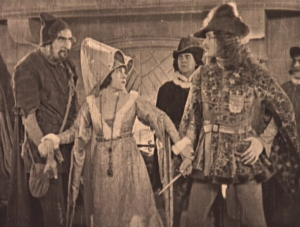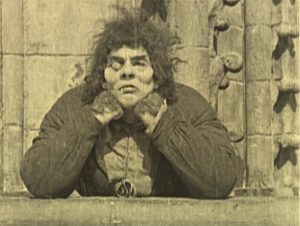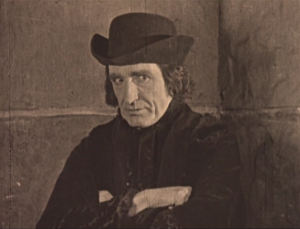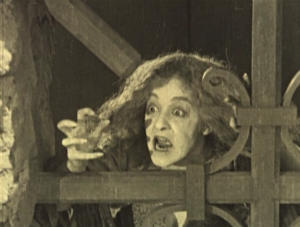There are three basic problems with the plot the 1923 version of the Hunchback of Notre Dame; its strong adherence to parts that don’t make any sense in the scope of the movie, the changes that had to be made to appease the almighty censors, and Lon Chaney.
The last problem really isn’t a problem but if you watch the opening scene you can see what I mean. The opening scene starts with the Feast of Fool and then it cuts away to Lon Chaney as Quasimodo basically mocking people from atop Notre Dame. I do appreciate that this is the only version to have Quasimodo that has a basic dislike for people like he does in the book which this scene shows nicely but to just an awkward way to introduce Lon Chaney as Quasimodo to the viewers and it ruins the pacing and makes the beginning boring.
The second issue has to do with censorship laws of the time. The law that pertains to Hunchback is a movie couldn’t cast a priest in a negative light, meaning we can’t have a Priest lusting after a women. So much like the 1939 the role of the Frollo sinner is cast on the “Jehan” character the “Claude” character is the saintly priest. Unlike the 1939 version Jehan in this version has no reason why he can’t make a straight up move on Esmeralda. Nothing is stopping him; no conflict of her being a Gypsy or no implied religious morality getting in the way. He’s just a coward with no real personality or motivation.
There is no confliction for this Jehan so there is no interest. The plot of the book is hinged on Frollo’s obsession with Esmeralda so if there is no torment where does the interest to the plot lie? Well in this case the interest to the plot is Lon Chaney’s Quasimodo, so back to that issue, remember this film started the “Quasimodo is main character” mentality that the many of the films buy in to .
The finally issue is a weird one to be an issue because when we compare movies to book there is a part of us that wishes that the movie would follow the book perfectly and we get up annoy by what the movie misses or adds. However it is hard to make a movie follow the book perfectly as they are two different median for story telling. One aspect of the book that I wish made into more movies is the Sister Gudule sub-plot. Sister Gudule is Esmeralda’s mother. The 1923 version is one of the few version to have this sub-plot however it goes no where. We get the back story of how Esmeralda was taken and we see Gudule curse her and then as Esmeralda is about to die Gudule realizes Esmeralda is her child and then I guess she dies. So Esmeralda doesn’t learn this, it amounts to nothing. It was just there because it was in the book but if Esmeralda doesn’t learns this and where is the emotion in the end what was the point?

Esmeralda (Pasty Ruth Miller), Phoebus (Norman Kelly) and Clopin (Ernest Torrence) Ball Scene Hunchback of Notre Dame 1923
Another sub-plot that was added was this division of the nobel and the poor. Now this was a bigger point in the 1939 version here’s it amount to one scene where Phoebus brings Esmeralda to a party and he dresses up and tries to pass her off as a Princess and the party is broken up by Clopin and Esmeralda sadly rejects Phoebus. Like Gudule, these scene that revolve around the classes don’t add to very much to the over all plot
It’s not that entire plot and pacing of the 1923 version is bad it’s just following the book too closely wrecked the pacing and the removal of Frollo’s torment ruins the emotional intensity. The “Chaney being forced” to the audiences was just the opening so it wasn’t a major problem but it’s the reason why the film doesn’t have a very strong opening scene.
Next Time- Characters starting with Quasimodo

Quasimodo (Lon Chaney), Esmeralda (Patsy Ruth Miller) and Gudule (Gladys Brockwell) Hunchback of Notre Dame 1923
Follow thehunchblog






I fully agree that since Frollo in the 1923 version is not a priest (having previously quitted the job) and he is not some highly conservative, over-religious judge or other public figure either, there was nothing stopping him from marrying Esmeralda or having her as a girlfriend (besides Esmeralda’s consent, that is). So, yes, unlike his 1939 counterpart, there was indeed no reason why he could not make a move on Esmeralda. But there is one thing that has not been mentioned so far: unlike Claude Frollo in the novel or Frollos in other adaptations, the 1923 Frollo *did* make a particularly straightforward move on Esmeralda. Of course I am referring to the fact that he asked to marry her. Esmeralda lived with Clopin who was her guardian in this version and, unlike other Frollos, the 1923 Jehan would not just follow her around but he actually visited her at home. At first, Jehan kept going to her home to visit Clopin for whatever business they had together but pretty much every viewer could guess that Jehan was mainly going there to see Esmeralda even if they would not usually speak as she was not comfortable around him and she would often leave whenever he showed up. And about halfway through the movie, Jehan made a direct (though not exactly honourable) proposal when he asked Clopin to give him Esmeralda in order to marry her and in exchange he offered to give Clopin Notre Dame’s treasure or something. Ultimately, Clopin did not let Frollo have Esmeralda but he did seem, at first, to consider it as an option. I don’t remember any other Frollo making such a move. Frollos who are judges somehow seem to feel it is wrong because of her background (usually because they are prejudiced against gypsies) and Frollos who are priests obviously can’t because of their vows so either way they have to stick to stalking her. By contrast, the 1923 Frollo knew that there was nothing holding him back and he was bold enough to take full advantage of it every time he had the opportunity.
Yup…it’s always the missing footage. Back then I don’t think the characters were as carefully planned out as they are today.
That’s true, Jehan is meant to be a villain no more no less, so there is no depth to him like his novel counter-part. That inter-text card about him being a priest was just a courtesy to the novel.
Thanks for the support. I think a lot of oehtrs prefer Keaton these days. But after recently re-watching The Kid, The Gold Rush and The Circus on the one hand, and The General, Sherlock Jr., Our Hospitality and The Navigator on the other, I stand by my choice of Chaplin.Tomorrow I’ll have Part Two of this essay up. It runs nearly a thousand words (okay, so I went a little nuts).
To belatedly aswenr Lon’s question, because I received this info in a piecemeal e-mail, and posted it likewise. Again likewise, I can now report that, as always, Boris beat out Bela: the Dracula poster sold for US$310,700, so the record price for The Mummy still stands. Somewhat surprisingly, the other big winner was the insert for Freaks, which went for US$107, 550. The two Chaneys sold for US$50,787.50 and US$41,825 sorry, Lon! Meanwhile, the poster for The Adventures Of Robin Hood that I was coveting sold for US$11,325.50. (Hey, I could have afforded that, provided I was willing to give up well, everything.)
Yeah, I never really understood why they switch up Claude and Jehan and then decided to take away all the Frollo torment. In this version they say Jehan Frollo is a fallen priest, who decided to trade in the cloth for a more secular lifestyle. So, there’s technically nothing preventing him from making a pass at Esmeralda, unless the writers/directors of the movie decided to leave something out and 100 yrs. from now will be added back in and make that part make sense. Had the writers/directors mentioned a superstition that would make sense…or maybe he just hasn’t ever been with a woman before and still thinks girls have cooties. At any rate, it is something that never made sense to me either.
That’s true there is a mention of that Jehan was former priest which makes it worse because it ruins the tension and drama that the “Frollo” character should have. This Frollo has no drama and no personality. Though now that you mention it, there is 15-20 minutes missing from 35mm version (which is the version we enjoy today) so maybe there is some depth to Jehan in those lost minutes though I doubt it. I know there is a scene where Quasimodo gets cloths for Esmeralda but other than that those minutes are a mystery. Maybe I can do some more research on the missing footage.